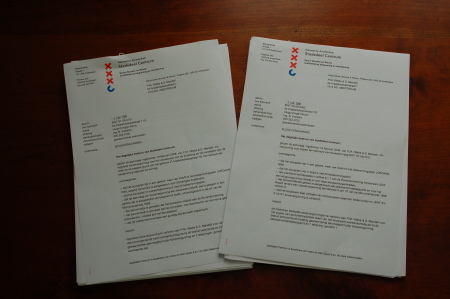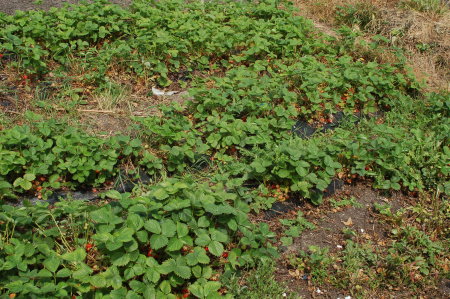I’ve posted a few times about the production of garlic seeds but haven’t gone into a lot of depth. Honestly, I don’t know very much, but I hope to learn more this year.
The basic idea is this. Garlic normally reproduces asexually, either through root divisions in the form of cloves that can be replanted to grow more bulbs, or bulbils that form on the tops of some garlic varieties. Garlic does not normally produce true flowers that can cross pollinate with neighboring plants. Perhaps at one time in it’s evolution it did reproduce sexually, and it’s been observed that sometimes when you remove the bulbils as they are developing it can cause the plant to try to reproduce sexually. Some people have had success making garlic seed in this way.
This is reported to be a very difficult and tedious process.
Some people reading this know that shallot seeds have become available in the last few years, something that likely came about from a similar process.
I’ve been chatting informally via email with someone named Avram who lives in Oregon and has been doing this for some years now. He has sent me a lot of interesting information.
Recently Avram gave me permission to go through our private emails, and cut and paste some of the more relevant parts into an Internet post. That’s the purpose of this post.
Some things like Avram’s personal notes or contacts, or some research papers he forwarded me I’m not going to publish on the Internet. I’m also going to replace some people’s names with initials to protect their privacy. If you want some of these things, or you want to get in touch with Avram, please send me an email and let me know. If you send me an email and tell me you want to get in touch with Avram, I’ll forward your email to him and he will get in touch with you if he wants.
—
Text in bold are excerpts of email I sent to Avram.
Block quoted text are excerpts of email Avram sent to me.
—
Hi Patrick. JG forwarded your e-mail to me. You had asked him primarily about rust in garlic. On that i know little as i haven’t experienced it. Here’s a couple of sites that deal with disease:
http://plant-disease.ippc.orst.edu/plant_searchResults.cfm?search_str=garlic&host_alpha=Select&host_text=garlic&submit=++Go%21++
http://www.ipm.ucdavis.edu/PMG/selectnewpest.onion-and-garlic.html
I have grown garlic for about 13 years and have grown around 150 supposed cultivars. Currently i have 80 accessions. I just got some land i can actually farm on so instead of growing around 400 lbs. i’ll hopefully grow over 2000.
This is worth reading: http://www.ars.usda.gov/Research/docs.htm?docid=5232
It is very helpful to read the Volk study: http://www.garlicseedfoundation.info/allium_sativum_DNA.htm If you can get through the academic language, this study is important to understanding garlic.
In the classification system popular in the States, there are 10 categories. Gatersleben uses a different system. The Volk study looks at genetics. I find that after 3-5 years of adaptation that variation in some categories is next to nil. The Volk found that there was a lot of duplication both within the USDA collection and in two major garlic seed (clone) companies: Filaree and The Garlic Store. The SSE collection is filled with duplicates!
In terms of true seed, most garlic is male infertile. Fertility is often indicated by the presence of purple anthers, though there are exceptions. The USDA has done seed production viability studies; however i’ve had very good results on varieties they have not and vice versa. Seed production tends not to be consistent on varieties one year
to the next. Let me know if you’re interested in doing it. I can tell you that is is very time consuming, that breeding new varieties will take years and that professionals have already produced millions of seeds and grown out out numerous generations of progeny. My first year i got a few seeds, none germinated. The next, i plucked bulbils from over 80 inflorescences, got 37 seeds and only one germinated. This last
year i plucked from 132, got 371 seeds and i have started them yet. My one seedling is very strange. It’s in a pot and still growing….
In my SSE listing i had asked if anyone was working on this in hopes of dialog with anyone else but have had no response. Other than the USDA and the Israelis, i don’t know of anyone still working on this. I think agribusiness growers gave up as they found it not cost effective for seed to bulb to seed crop production, especially with cheap imports from China.
A short time ago, you left a comment here on my blog, but didn’t leave
an email address so I didn’t know how to get in touch with you:
http://bifurcatedcarrots.eu/?p=219#comments
Hi Patrick. Funny i left that comment. I’ve never posted a comment before on the computer and didn’t think it actually worked. In winter i look on the net to find a new research into seed production and one of my searches led me to your site.
The Volk study found that all but one of the Porcelain phenotypes tested were duplicates. My observation concur with this with one exception: Mexican Red, a nebulous name for a garlic which looks and tastes like every other Porcelain except that it has purple anthers and produces seed. I did get viruses on most of my Porcelain which made it that much easier to discontinue most of them. I also found that most of the Artichokes were barely distinguishable after 3-5 years. Turbans as well. I have trialled Turbans collected by friends, family, a neighbor’s friend’s missionary daughter, etc. from places like Corella, Euzkadi (Basque territory), Eastern Kazakhstan, Uzbekistan, Turkmenistan,Thailand, China, Sonoran desert region (USA), etc. Sometimes i think there’s better color in one to the next or that average maturity dates are a little off but if the sampling is large enough even these “differences” are unconvincing. Leaf architecture, width, length, scape length, maturity dates, anthers, etc–these are all basically the same, /in my climate, soil, and latitude/ here in SW Oregon. When i got the Turban that friends brought back from Bangkok it was a white bulb with white cloves and an odd cloves configuration. After 2 seasons it was a typical Turban. My soil and water have a high iron content which affects coloration. The category i’ve seen the most diversity in is Asiatics. I have yet to see two identical cultivars. Most interesting to me are the one that do not fit into any of the categories. I have several in my collection including a few collected in the wild. If you have the ’04 SSE Harvest Edition there is an article by Rich Hannon on a seed collection mission in Turkmenistan. I am growing the two garlic he found (2nd year). In the first season they changed from where they had been adapted to (Pullman, WA, Southeastern WA state) but neither was particularly viable for seed production. We shall see.
Here are a couple more links.
this is Gatersleben and it’s interesting to see how they classify.
http://pgrc-35.ipk-gatersleben.de/apps/gcc/core_collection.htm#_Taxonomic_Af
the garlic and health project was based in the NL. this is the results page, though there is much more on the site. Interestingly i too found that application of sulfur fertilizer increased pungency in garlic and it’s a fun thing to experiment with.
http://www.plant.wur.nl/projects/garlicandhealth/Results.htm
I am attaching a research paper. It is current and it gives you an idea of how far the true seed thing has been taken, at least by Israelis who have some very well funded research. It’s a little discouraging at times to do so much work on something that others have already taken a long long way but i am a garlic geek, a grower not a scientist and i want to breed my own varieties.
Hi Patrick. I recall you looking in to rust in garlic. I was looking in some old Garlic Seed Foundation zine and found a note that you probably already know but i thought i’d share with you.
“Rust is caused by /Puccinia porri./ It varies on different hosts and different strains of the fungus have different levels of virulence to various allium species. The fungus overwinters as spores on field trash and hedge rows and is blown long distances in the wind. The disease occurs most frequently under conditions of high humidity and low rainfall (immersion in water reduces spore viability). Spores need at least 4 hours at 97% RH to germinate and infect. Rust is enhanced by plant stress from too wet, too dry and excessive nitrogen. Control is limited”… Basically clean seed, good crop rotation, separate field and control of allium weeds.
Hi Avram,
I have another question for you.
At what stage do you usually pluck the bulbils? Do you do it while the scape is still fairly immature, or do you wait until the bulbils have begun to develop and are exposed?
About what date do you usually start this?
Hi Patrick. I’ve experimentented with different things. I’ve cut the scapes before elongation, put them in water and eventually they elongate, swell and open. I’ve left them to natuarlly elongate, and open. I’ve foliar fed them to keep vegetative growth process to continue as long as possible. My best result was to do this: foliar feed weekly to try to keep the plant alive and pluck the bulbils when the spathes began to open. When the stems really started dying i cut them and put them in water. I’ve hand pollinated with small paint brushes but the bees seem attacted to them and i’ve rubbed cut inflorescences against others during anthesis. As far as plucking goes, i’ve tried a number of different tweezers. Some varieties are easy, others are very difficult. There seem to be layers that emerge at at different times. It’s challenging to avoid breaking the pedicals, the delicate flowers stalks while plucking.
It’s been a very cool wet Spring here. Usually, or at least since i’ve been keeping records, i’ve harvested all the Turbans and started on some of the Asiatics. This year i’ve harvested only two experimental varieties from SE Asia. Great year for brassicas, not so good for solanums, except spuds. I’m delving into the world of tractors and implements to work up the pasture and get it cover cropped. While last year i plucked bulbils from 131 plants, i don’t see myself having the time to do as much this year, especially becuase none of the 370 or so seeds i collected germinated which is very discouraging. The one plant i grew from seed is doing great, potted up and in its second year.
How’s your season thus far? How’s the garlic look? When is your harvest period?
I’m attaching my records from last year. The nebulously named “Mexican Red” is the only Porcelain appearing bulb to have purple anthers that i’ve experimented with and i’d hoped it’d be good for crosses.
I don’t recall what all links i gave you but here’s the updated ATTRA publication (they are the BEST resource for organic/sustainable agriculture i’ve found.
http://attra.ncat.org/calendar/new_pubs.php/2008/04/11/garlic_organic_production
This is another interesting one: http://www.bignewsforgarlic.com/
Hours of reading here: I have a glossary of botanical nomenclature handy when pouring though any of the academic research. http://igb.agri.gov.il/allium_page.pl#Allium_Collecting_Missions_and_Research_Activity



